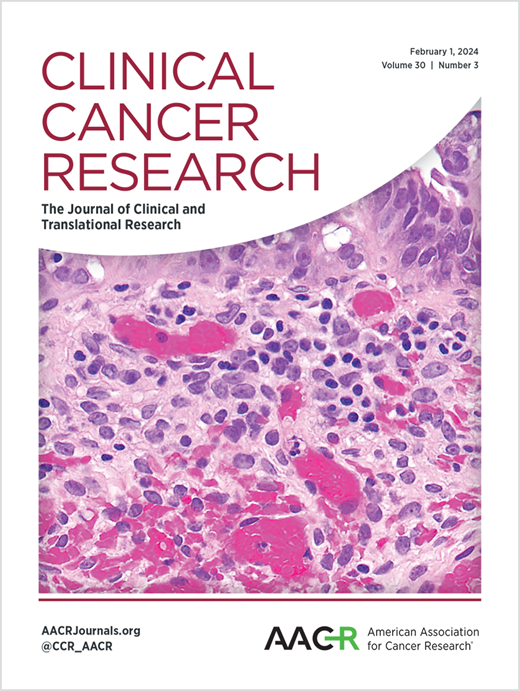Direct Comparison of Alternative Blood-Based Approaches for Early Detection and Diagnosis of HPV-Associated Head and Neck Cancers
IF 10
1区 医学
Q1 ONCOLOGY
引用次数: 0
Abstract
Purpose: The incidence of human papillomavirus (HPV)–associated head and neck squamous cell carcinoma (HPV + HNSCC) is increasing in the United States. Currently, there are no early detection approaches for HPV + HNSCC. Two blood-based analytes for early detection and diagnosis of HPV + HNSCC, circulating tumor HPV DNA (ctHPVDNA) and HPV early protein antibodies (HPV Ab), show promise, yet current approaches lack adequate diagnostic accuracy for broad clinical utility. Further, performance metrics across various assays for detecting these analytes alone or in combination have not been compared head-to-head. To address these limitations and knowledge gaps, we developed a multifeature HPV whole-genome sequencing (WGS) liquid biopsy for improved low-level ctHPVDNA detection. We defined the performance characteristics of this WGS-based approach and compared it head-to-head with existing blood-based HPV detection approaches to determine the optimal single or combinatorial biomarker strategy for a future prospective study of HPV + HNSCC early detection. Experimental Design: We tested blood samples from 304 participants: 152 patients with untreated incident HPV + HNSCC (77% stage I) and 152 general population control patients. We compared WGS-based ctHPVDNA detection, single-plex Droplet Digital PCR (ddPCR)–based ctHPVDNA detection, multiplex ddPCR-based ctHPVDNA detection, multiplex HPV Ab detection, and clinical standard-of-care tissue biopsy, benchmarked to gold-standard HPV + HNSCC tissue diagnosis. We then modeled the operational feasibility of these approaches as screening biomarkers for HPV + HNSCC. Results: HPV WGS sensitivity and specificity were 98.7% and 98.7%, respectively. Single-plex ddPCR sensitivity and specificity were 94.2% and 98.6%, respectively. Multiplex ddPCR sensitivity and specificity were 90.6% and 96.3%, respectively. HPV Ab sensitivity and specificity were 86.4% and 96.3%, respectively. A combinatorial approach using both HPV WGS and HPV Ab yielded a sensitivity and specificity of 87.4% and 98.8%, respectively. In a head-to-head comparison, HPV WGS demonstrated significantly improved diagnostic accuracy compared with ddPCR (Youden index for HPV WGS, 0.99 vs. ddPCR, 0.90; P < 0.001), HPV Ab (HPV WGS, 0.99 vs. HPV Ab, 0.83; P < 0.001), and clinical workup (HPV WGS, 0.99 vs. clinical workup, 0.82; P < 0.001), which was maintained when evaluating only early-stage disease cases. For men ages 55 to 74, HPV WGS yielded the lowest number needed to screen (2,903 men) and the highest positive predictive value (2.6). Conclusions: HPV WGS–based ctHPVDNA detection demonstrated the highest sensitivity, specificity, and diagnostic accuracy and thus the lowest number needed to screen and highest positive predictive value compared with ddPCR-based ctHPVDNA detection, HPV Ab–based detection, and combinatorial approaches. These results highlight the promise of HPV WGS liquid biopsy for screening and early detection of HPV + HNSCC and the need for modeling and cost-effectiveness studies to evaluate and guide screening implementation.早期检测和诊断hpv相关头颈癌的不同血液检测方法的直接比较
目的:在美国,人乳头瘤病毒(HPV)相关的头颈部鳞状细胞癌(HPV + HNSCC)的发病率正在上升。目前,没有HPV + HNSCC的早期检测方法。两种基于血液的分析方法用于HPV + HNSCC的早期检测和诊断,循环肿瘤HPVDNA (ctHPVDNA)和HPV早期蛋白抗体(HPV Ab),显示出希望,但目前的方法缺乏足够的诊断准确性,无法广泛应用于临床。此外,用于单独或组合检测这些分析物的各种测定方法的性能指标尚未进行正面比较。为了解决这些局限性和知识空白,我们开发了一种多特征HPV全基因组测序(WGS)液体活检,以改善低水平ctHPVDNA的检测。我们定义了这种基于wgs的方法的性能特征,并将其与现有的基于血液的HPV检测方法进行了比较,以确定未来HPV + HNSCC早期检测前瞻性研究的最佳单一或组合生物标志物策略。实验设计:我们检测了304名参与者的血液样本:152名未经治疗的HPV + HNSCC患者(77%为I期)和152名普通人群对照患者。我们比较了基于wgs的ctHPVDNA检测,基于单滴数字PCR (ddPCR)的ctHPVDNA检测,基于多重ddPCR的ctHPVDNA检测,多重HPV Ab检测和临床标准护理组织活检,以金标准HPV + HNSCC组织诊断为基准。然后,我们模拟了这些方法作为HPV + HNSCC筛选生物标志物的操作可行性。结果:HPV WGS的敏感性为98.7%,特异性为98.7%。单链ddPCR的敏感性和特异性分别为94.2%和98.6%。多重ddPCR的敏感性为90.6%,特异性为96.3%。HPV抗体敏感性和特异性分别为86.4%和96.3%。使用HPV WGS和HPV Ab的组合方法的敏感性和特异性分别为87.4%和98.8%。在头对头比较中,与ddPCR相比,HPV WGS的诊断准确性显着提高(HPV WGS的约登指数为0.99,ddPCR为0.90;P, lt;0.001), HPV抗体(HPV WGS, 0.99 vs. HPV抗体,0.83;P, lt;0.001)和临床检查(HPV WGS, 0.99 vs.临床检查,0.82;P, lt;0.001),仅在评估早期疾病病例时保持不变。对于55岁至74岁的男性,HPV WGS产生的筛查所需人数最少(2903人),阳性预测值最高(2.6人)。结论:与基于ddpcr的ctHPVDNA检测、基于HPV抗体的检测和组合方法相比,基于wgs的HPV ctHPVDNA检测具有最高的灵敏度、特异性和诊断准确性,因此需要筛选的数量最少,阳性预测值最高。这些结果突出了HPV WGS液体活检筛查和早期检测HPV + HNSCC的前景,以及需要建模和成本效益研究来评估和指导筛查实施。
本文章由计算机程序翻译,如有差异,请以英文原文为准。
求助全文
约1分钟内获得全文
求助全文
来源期刊

Clinical Cancer Research
医学-肿瘤学
CiteScore
20.10
自引率
1.70%
发文量
1207
审稿时长
2.1 months
期刊介绍:
Clinical Cancer Research is a journal focusing on groundbreaking research in cancer, specifically in the areas where the laboratory and the clinic intersect. Our primary interest lies in clinical trials that investigate novel treatments, accompanied by research on pharmacology, molecular alterations, and biomarkers that can predict response or resistance to these treatments. Furthermore, we prioritize laboratory and animal studies that explore new drugs and targeted agents with the potential to advance to clinical trials. We also encourage research on targetable mechanisms of cancer development, progression, and metastasis.
 求助内容:
求助内容: 应助结果提醒方式:
应助结果提醒方式:


